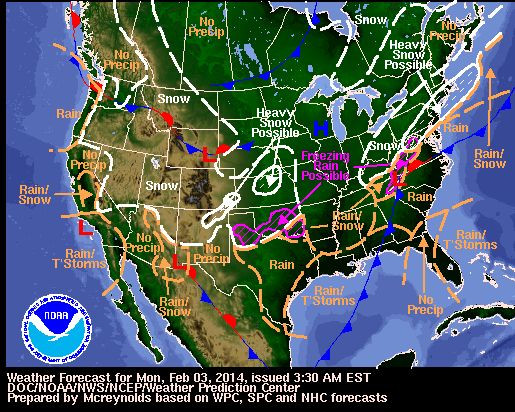Winter Storm Maximus Kicks Off Snowy Start To February: Will Groundhog's Long Winter Prediction Come True?

Just a day after Punxsutawney Phil poked his head out of a fake tree stump and saw his shadow, the weather seems to be shaping up to fulfill the groundhog’s prognostication for six more weeks of winter – on the East Coast, at least.
“The latest [National Oceanic and Atmospheric Administration] 8 - 14 day outlook calls for a winter pattern very similar to what was observed in December and January: the east half of the national colder than average, and the west half warmer than average,” Weather Underground meteorologist Jeff Masters wrote on Monday.
A winter storm, dubbed Maximus by The Weather Channel, is raking the Northeast with snow and slush this Monday. Maximus is expected to dump somewhere between 4 to 8 inches of snow on New York City. The heaviest accumulations n Monday will be in a swath stretching from northern West Virginia into New Jersey, according to TWC. The National Weather Service has issued Winter Storm Warnings from New York to Pennsylvania and West Virginia.
This snowy start to February will probably be a trend for the first half of the month.Two other winter storms are expected in the near future in the NYC metro area, according to Accuweather. A second storm is slated to drop in the middle of next week, and a third next weekend (possibly making for a snowy Valentine’s Day, so plan accordingly).
Meanwhile, the Western states would probably welcome a winter storm or three. A persistent drought is showing no signs of letting up, and the effects can be felt everywhere: pollution in the Los Angeles Basin, unchecked by rain, is worsening; farmers are selling off cattle and abstaining from planting crops in the parched Earth. The Sierra Nevada snowpack that acts as a reservoir for much of California stands at just 12 percent of the average measurement – the lowest level in the last 50 years that the snowpack’s been measured.
So, should East Coasters blame the groundhog for this resurgence in frigidity? Probably not. Researchers at NOAA’s National Climatic Data Center took a look at Phil’s track record, and found it wanting. From 1988 to 2013, Punxsutawney Phil correctly predicted the temperature trend for February 11 times and muffed the forecast on 15. Not exactly a prognosticator to set your watch to.
“The table shows no predictive skill for the groundhog during the most recent years of this analysis,” the NCDC wrote. “It really isn't a ‘bright’ idea to take a measure such as a groundhog's shadow and use it as a predictive meteorological tool for the entire United States.”
But it’s not really the rodent’s fault that he’s a poor meteorologist.
“Phil’s prediction is determined ahead of time by a group [of humans] called the Inner Circle, who wear top coats and tuxedos to the annual Groundhog Day ceremony,” Time magazine explained Sunday.
© Copyright IBTimes 2024. All rights reserved.





















